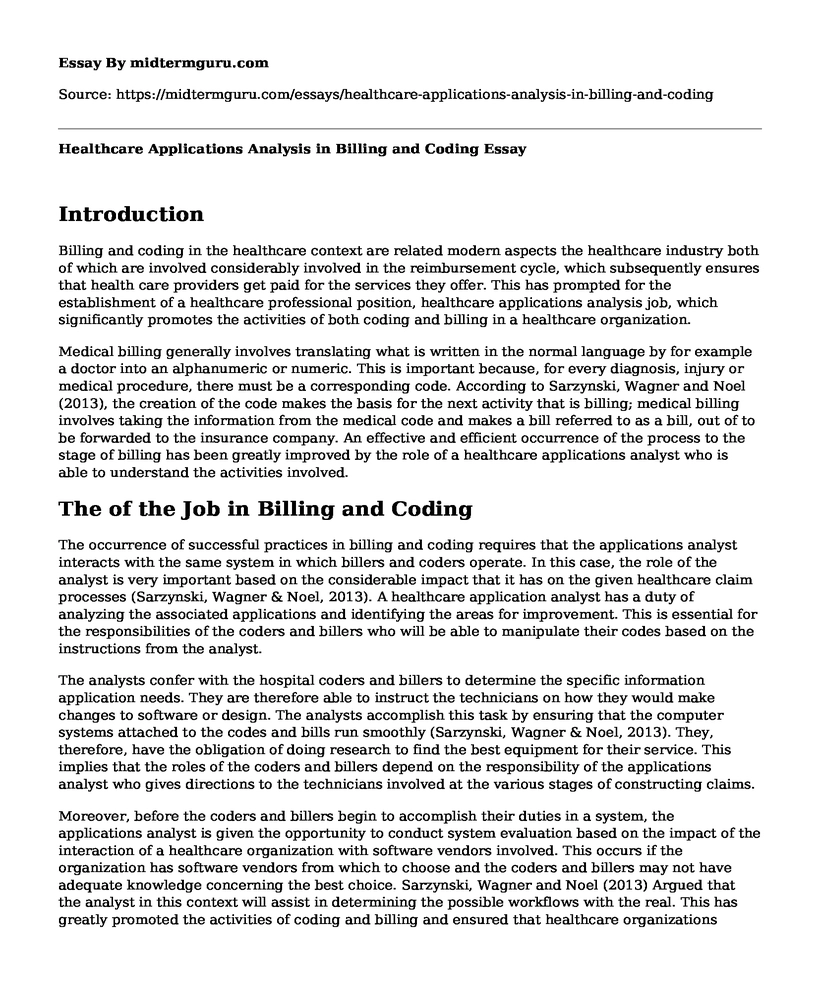Introduction
Billing and coding in the healthcare context are related modern aspects the healthcare industry both of which are involved considerably involved in the reimbursement cycle, which subsequently ensures that health care providers get paid for the services they offer. This has prompted for the establishment of a healthcare professional position, healthcare applications analysis job, which significantly promotes the activities of both coding and billing in a healthcare organization.
Medical billing generally involves translating what is written in the normal language by for example a doctor into an alphanumeric or numeric. This is important because, for every diagnosis, injury or medical procedure, there must be a corresponding code. According to Sarzynski, Wagner and Noel (2013), the creation of the code makes the basis for the next activity that is billing; medical billing involves taking the information from the medical code and makes a bill referred to as a bill, out of to be forwarded to the insurance company. An effective and efficient occurrence of the process to the stage of billing has been greatly improved by the role of a healthcare applications analyst who is able to understand the activities involved.
The of the Job in Billing and Coding
The occurrence of successful practices in billing and coding requires that the applications analyst interacts with the same system in which billers and coders operate. In this case, the role of the analyst is very important based on the considerable impact that it has on the given healthcare claim processes (Sarzynski, Wagner & Noel, 2013). A healthcare application analyst has a duty of analyzing the associated applications and identifying the areas for improvement. This is essential for the responsibilities of the coders and billers who will be able to manipulate their codes based on the instructions from the analyst.
The analysts confer with the hospital coders and billers to determine the specific information application needs. They are therefore able to instruct the technicians on how they would make changes to software or design. The analysts accomplish this task by ensuring that the computer systems attached to the codes and bills run smoothly (Sarzynski, Wagner & Noel, 2013). They, therefore, have the obligation of doing research to find the best equipment for their service. This implies that the roles of the coders and billers depend on the responsibility of the applications analyst who gives directions to the technicians involved at the various stages of constructing claims.
Moreover, before the coders and billers begin to accomplish their duties in a system, the applications analyst is given the opportunity to conduct system evaluation based on the impact of the interaction of a healthcare organization with software vendors involved. This occurs if the organization has software vendors from which to choose and the coders and billers may not have adequate knowledge concerning the best choice. Sarzynski, Wagner and Noel (2013) Argued that the analyst in this context will assist in determining the possible workflows with the real. This has greatly promoted the activities of coding and billing and ensured that healthcare organizations achieve informed claims.
Effective Ideas Required of an Applications Analyst
An analyst in the healthcare context should be able to interact with both the departments of their organizations and their external vendors. This is necessary because the vendors have the first-hand information regarding the functionalities of the systems to be analyzed. Working closely with the various departments of the organization in question is important in gathering data before carrying the necessary evaluative practices to the healthcare system (Sarzynski, Wagner, & Noel, 2013). As a result, the subsequent exercises of coding and billing and be accomplished based on a definite basis hence making them effective. Organizing, processing and documentation of the ideas can be used to assist with revenue and quality metrics based on coding.
References
Sarzynski, E., Wagner, D., & Noel, M. (2013). Expanding the objective structured clinical examination (OSCE) to teach documentation, coding and billing. Medical Teacher, 35(8), 699-700. doi: 10.3109/0142159x.2013.786174
Cite this page
Healthcare Applications Analysis in Billing and Coding. (2022, Aug 31). Retrieved from https://midtermguru.com/essays/healthcare-applications-analysis-in-billing-and-coding
If you are the original author of this essay and no longer wish to have it published on the midtermguru.com website, please click below to request its removal:
- Essay on Quality Indicators of Anesthesia
- Essay on Promoting Health Quality in Organization Culture
- Social Work Case Study: Olivia
- Paper Example on Nursing Professional Identity
- Effects of Technology on Physical Therapy - Paper Example
- From Gambling to Tutoring: How I Learned to Take Responsibility - Essay Sample
- Jensen Pharma Announces 3-Month Investigation of Dekanor - Essay Sample







